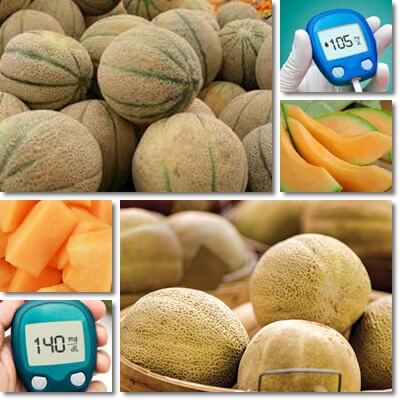Can diabetics eat cantaloupe? Yes, diabetics can eat cantaloupe, but in small amounts, as part of an overall healthy, balanced and varied diet.
Intake may differ from one diabetic patient to another and must be tailored to one’s individual nutritional requirements and the dietary restrictions of the metabolic condition.
The major benefits of cantaloupe for diabetes are the moderate total carbohydrate and sugar content as well as low glycemic load.
The fruit is also an important source of vitamin C for wound healing and cardiovascular health, pro-vitamin A antioxidants for skin and has a varied B vitamin and mineral profile which contributes to skin, nervous system and cardiovascular benefits.
What is the difference between cantaloupe and muskmelon?
The term cantaloupe is rather ambiguous as it refers to different varieties of the same melon from different regions of the world. Technically, all cantaloupes are muskmelons (but not vice-versa).
The European variety (Cucumis melo var. cantalupensis) is considered the original cantaloupe and distinguishes itself by a thicker, but more finely netted to smooth, pale or light green, tan or grayish skin.
When present, ribs are more delicate. The North American variety (Cucumis melo var. reticulatus) has a thinner, but more reticulated skin (the net-like structures are rougher, more prominent) and is light grey to pale yellow in color. Ribs may or may not be present. Both varieties have a sweet, flavorful, fragrant, light orange flesh and similar nutritional profiles, especially macronutrients profile.

When looking to determine if you can eat cantaloupe with diabetes or not, there are several nutritional aspects to consider: carbohydrate, sugar and fiber content, energetic value, glycemic index and glycemic load.
These are the major factors that will determine serving size. In theory, most diabetics can eat almost any fruit as long as amounts consumed are small enough so they don’t cause any significant raise in blood sugar levels.
But for those with severe insulin resistance, difficulty in maintaining a steady, healthy weight, complications of the condition and trouble keeping to the dietary restrictions of their condition, even relatively small intakes may be problematic and generate both short and long term side effects. As such, some diabetics may eat small amounts of the fruit occasionally, while others may need to avoid it completely.
How many carbs and how much sugar in cantaloupe?
Cantaloupe carbohydrate content: 8.16 g of total carbohydrates/100 g of the fruit, most of which are simple sugars, 7.86 g, and less than 1 g dietary fiber.
Dietary fiber doesn’t contribute to blood sugar levels because it’s an indigestible carbohydrate, meaning it’s not digested and passes unchanged through the gastrointestinal tract.
Even better, it slows down digestion and emptying of the stomach, contributing to a slower absorption of the simple sugars and a steadier rise in blood sugar levels, which is good for diabetes.
The amount of sugar in cantaloupe (7.86 g of simple sugars/100 g of fruit) is not excessive which means that diabetic patients with good management of their condition may consume small amounts of the fruit occasionally.
To reduce the risk of blood sugar spikes, diabetics can:
1) See a dietitian for a personalized eating plan suited to their individual nutritional requirements and the restrictions of their condition.
2) Limit intake to one serving a day and avoiding eating cantaloupe every day.
3) Enjoy the fruit after a light protein, low carbohydrate meal. For example, have a small serving of cantaloupe and cottage cheese or Greek yogurt or some nuts (if you are not allergic).
4) Exercise after eating fruit to help prevent too rapid rises in blood sugar levels. Even the lightest form of exercise such as a walk is good.

Cantaloupe glycemic index and load
Cantaloupe glycemic index is 65 (moderate). The glycemic index (GI) is a scale that measures how fast the carbohydrates in a plant food raise blood sugar levels, compared to pure glucose. A value below 55 is a low GI.
Between 55-69 is a medium GI. Between 70-100 is a high GI. Generally, diabetics are advised to choose low glycemic fruits which are less likely to cause too rapid rises in blood sugar levels if consumption is limited to small amounts.
But the glycemic index is determined for 50 g of carbohydrates, not serving size.
By comparison, the glycemic load (GL) takes into account actual serving size of various plant foods and determines how much a rise in blood sugar levels it causes.
A glycemic load of 10 or less is low. Between 11-19 is moderate. Over 20 is high.
The glycemic load is calculated by dividing the glycemic index of a food by 100, then multiplying it by the grams of carbohydrates in a serving size.
A serving of 100 g of cantaloupe has 7.86 g of carbs (except fiber) and the fruit has a GI of 65.
The glycemic load of cantaloupe thus is 65/100 X 7.86= 0.65 X 7.86 = 5.1 (estimate: 5, low).
So while it has a moderate glycemic index (65), the glycemic load is low (5) which makes it a relatively safe choice for diabetics when consumed in limited amounts, as part of a healthy, varied diet.
Energetic value (calories)
Cantaloupe calories: 34 kcal/100 g. The energetic value of foods also matters in a diabetic diet.
The higher the energetic value of a food, the higher the chances of said food causing weight gain over time.
And since diabetics must maintain a healthy weight, it is imperative they manage their calorie intake.
Fortunately, fruits like cantaloupe are low-calorie and, given a moderate intake and an overall good diet, weight gain is unlikely.
Cantaloupe and gestational diabetes
Your doctor might recommend avoiding moderate and high glycemic index fruits such as cantaloupe and watermelon altogether if you have gestational diabetes so as to not pose any risks to the pregnancy, even though eating small amounts of cantaloupe or even watermelon occasionally may not affect blood sugar levels at all, especially if there is some meal planing beforehand and there are not dietary excesses. It’s best that follow your doctor’s recommendations closely.
Cantaloupe benefits for diabetes include
1) Doesn’t raise blood sugar levels too fast too much thanks to a moderate glycemic index (65), but low glycemic load (5).
2) Low calorie, low-fat, doesn’t promote weight gain.
3) Good vitamin C content (36.7 mg/100 g) for wound healing, a major issue for diabetics.
4) Source of pro-vitamin A antioxidants (over 20% of daily requirements) with benefits for skin.
5) Varied B vitamin profile, good for diabetes-associated nerve damage and skin.
6) Minor benefits for hypertension thanks to small amounts of potassium (267 mg/ 100 g of fruit). Cantaloupe potassium content is not extraordinary, but it does bring a good contribution to daily requirements which is good for diabetics struggling with high blood pressure as potassium helps regulate blood pressure.
